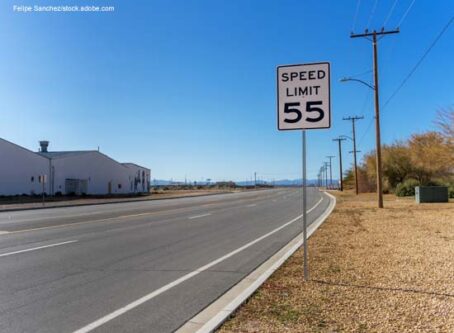Five states take steps to expand move-over rules
Changes to move-over rules are being pursued in statehouses across the country.
States historically limited move-over protections for emergency personnel. But over time, many expanded their protections to apply to vehicles that include road service, utility and tow trucks.
Some groups, including the Owner-Operator Independent Drivers Association, long have advocated to include large trucks and others in the common-sense rule. And in recent years, state legislatures have come on board to pursue and approve protections for all highway users.
At least 20 states now cover all highway users in their move-over law. Maryland adopted the rule two years ago, joining Arizona, Connecticut, Illinois, Iowa, Oklahoma, Oregon and Pennsylvania.
In the past year, about a dozen more states adopted move-over rule revisions that apply to all highway users. Others continue to take steps to do the same.
Georgia
Georgia House lawmakers unanimously approved a bill that would revise the state’s move-over law.
State law mandates vehicle operators to move over or slow down for stationary authorized emergency vehicles, towing or recovery vehicles, highway maintenance vehicles or utility service vehicles. The protection applies when the affected vehicles are displaying flashing lights or using traffic cones.
HB959 calls for including other vehicles in in the protection rule. Specifically, the revised rule would cover any vehicle with individuals present outside. The bill also would cover any vehicle displaying flashing hazard lights.
The rule would apply on any roadway with at least two lanes traveling in the same direction.
The bill is in the Senate Public Safety Committee.
Kansas
The Kansas Senate voted 38-2 to advance a bill to the House that addresses the state’s move-over rule.
State law requires travelers to move over or slow down when approaching vehicles that include law enforcement, emergency responders and utility vehicles with lights flashing along roadsides.
SB142 would expand the rule to cover any stopped vehicle displaying hazard warning lights, road flares or caution signals. A $75 fine would be included for unlawful passing of a stationary vehicle.
During a recent committee hearing, the Kansas Department of Transportation and Kansas Highway Patrol provided testimony in support of the bill.
KDOT shared with lawmakers that state crash statistics from 2018-2022 show 688 empty vehicles were struck while on the side of the road. The crashes resulted in 19 suspected serious injuries and 11 fatalities.
There were 64 crashes with someone in a vehicle on the side of the road during the same time period. These crashes resulted in two fatalities and one suspected serious injury.
“This enhancement makes it easier to educate the driving public, as now all drivers will be required to move over or slow down if there is a vehicle on the side of the road with flashing lights,” KDOT’s Joel Skelley testified.
The House Transportation Committee is scheduled to discuss the bill on Thursday, March 7.
Kentucky
The issue also is making progress at the Kentucky statehouse.
In place since 2003, Kentucky’s move-over law requires drivers to move over to the adjacent lane when approaching an emergency vehicle or public safety vehicle with flashing lights. If changing lanes is not possible or is unsafe, drivers are required to slow down and move with caution.
Covered vehicles include law enforcement, firefighters, paramedics and towing vehicles.
House lawmakers voted unanimously to advance a bill to extend the requirement to move over or slow down to include any disabled vehicle displaying a warning signal.
HB19 covers any vehicle displaying some type of warning signal, such as emergency flashers, flares or retroreflective signals.
AAA Bluegrass backs the pursuit. It reported that over a recent five-year period, nearly 30 people in Kentucky were struck and killed along roadsides. The group said all road users need to be protected when parked along the roadside for any reason.
The bill has moved to the Senate Transportation Committee.
New Jersey
In New Jersey, Gov. Phil Murphy recently signed into law a bill that expands move-over law protections to apply to any vehicle along the roadside.
The Garden State’s move-over law previously included protection for stationary emergency services, highway maintenance, tow trucks and sanitation vehicles.
Previously A5391, the new law requires drivers to move over when approaching a disabled vehicle with flashing hazard lights, road flares or reflective triangles. If changing lanes is not possible, drivers must slow down “below the posted speed limit.”
Violators would face fines between $100 and $500.
“Although common sense suggests motorists approaching a disabled vehicle should reduce speed and approach those vehicles with caution, current law does not explicitly require such action or impose fines for failure to do so,” Senate Transportation Committee Chair Patrick Diegnan, D-South Plainfield, said in prepared remarks before the bill became law.
The new rule took effect immediately.
Ohio
An Ohio Senate bill would expand the move-over law to include any stationary vehicle that is in “distress.”
SB178 states that “a vehicle is in distress when the operator indicates the condition through lit fuse, flares, red lights, red reflectors, red flags, emergency signs or flashing emergency/hazard lights.”
Failure to change lanes or proceed with caution when approaching a stationary vehicle in distress could result in a misdemeanor offense. Drivers with other traffic violations in the past year would face increased charges.
An additional $100 charge could result if distracted driving is determined to be a factor in failure to move over or slow down.
The bill is in the Senate Transportation Committee. LL









